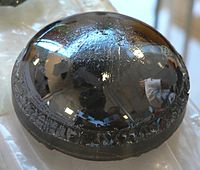
Photo from wikipedia
Photodegradation of toxic pollutants is a promising approach to deal with wastewater management. In this regard, MoS2/g-C3N4 (MSC) derived composites with varying weight-ratios were prepared via fast (30 min) one step… Click to show full abstract
Photodegradation of toxic pollutants is a promising approach to deal with wastewater management. In this regard, MoS2/g-C3N4 (MSC) derived composites with varying weight-ratios were prepared via fast (30 min) one step microwave-assisted method. The materials were characterized by XRD, XPS, EDS, FESEM and HRTEM to validate their flower-like and sheet-like morphologies. The PL and UV-vis DRS spectra exhibited low recombination-rate and band-gap (1.7 eV), which is appropriate for an effective visible-light degradation. Photocatalytic performance of the catalysts was analyzed by investigating the degradation of methylene blue (MB) as well as pesticide fipronil. Best results were obtained by 5:1 MSC (98.7% degradation efficacy; rate constant 0.0261 min-1) in 80 min under the sunlight. The effects of solution pH, catalyst-dose, scavengers and illumination-area were also explored. The catalyst was reusable as confirmed by degradation studies (~82% efficiency) even after 5-cycles. The photocatalytic treatment of real industrial-wastewater was also conducted. The TOC and COD analysis validated that the treatment by as-prepared catalyst is more proficient for effluent-treatment than the industrial physico-chemical treatments. Electrochemical degradation of MB was also investigated using the glassy carbon electrode modified with different MSC-ratios. The electrode modified with 5:1 MSC at pH 7 manifested the maximum peak current. The plausible mechanisms for photocatalytic and electrochemical degradations were proposed, which suggested the remarkable potential the prepared nanocomposites for wastewater treatment.
Journal Title: Journal of environmental management
Year Published: 2020
Link to full text (if available)
Share on Social Media: Sign Up to like & get
recommendations!